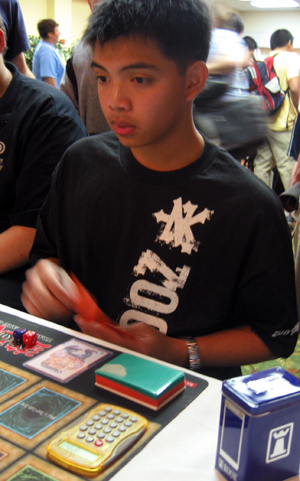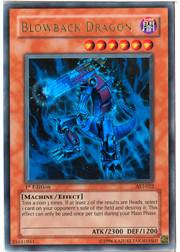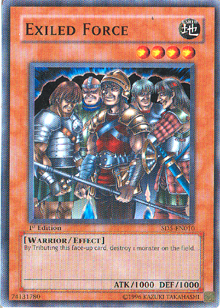
With the new format rapidly approaching, many players will turn to the decklists of previous Shonen Jump Championships to decide what they’ll play at SJC Boston. However, most decks in the past have been based around the most powerful cards of the time—Chaos Sorcerer and Tsukuyomi—that often ultimately decided which monsters would make the cut in any given deck and which wouldn’t. Now that they’re out of the picture, deck builders are free to roam as far as they want.
The Machine deck appears to be very powerful in the upcoming format. Cyber-Stein was tearing up the last format even with the backfire potential of Snatch Steal and Chaos Sorcerer. Now that those two are gone, Cyber-Stein can be played much more freely. The banning of Chaos Sorcerer and Tsukuyomi also frees up the popular Cyber Phoenix from being destroyed without drawing a card from your deck. This gives the Machine deck incredible strength. Machines are looking strong right out of the gate, and I expect many duelists will turn to Lazaro’s build as the most recent successful Machine build.
Here’s what Lazaro took to a Top 8 finish at SJC Hamilton:
Monsters: 21
3 Cyber Dragon
3 Cyber Phoenix
3 Dekoichi the Battlechanted Locomotive
2 Blowback Dragon
2 Magician of Faith
2 Cyber-Stein
1 Breaker the Magical Warrior
1 Exiled Force
1 Drillroid
1 Morphing Jar
1 Tsukuyomi
1 Sangan
Spells: 14
2 Enemy Controller
2 Smashing Ground
2 Nobleman of Crossout
1 Graceful Charity
1 Scapegoat
1 Snatch Steal
1 Mystical Space Typhoon
1 Limiter Removal
1 Premature Burial
1 Last Will
1 Heavy Storm
Traps: 5
2 Royal Decree
1 Mirror Force
1 Call of the Haunted
1 Torrential Tribute
Side: 15
3 Nimble Momonga
1 Cyber-Stein
3 Megamorph
3 Giant Trunade
2 Poison of the Old Man
1 Confiscation
2 D. D. Designator
 Lazaro’s Machines aimed to win games fast and in any fashion possible. Much like the Bazoo/Return decks of old, Lazaro tried to swamp the field quickly and back the opponent against the ropes. Once accomplished, he would use his position to force the opponent into making desperate moves and wasting spells and monsters just to stay alive. Despite what some may have thought, low life points were definitely a disadvantage last format. Lazaro abused that fact by running an insanely aggressive deck.
Lazaro’s Machines aimed to win games fast and in any fashion possible. Much like the Bazoo/Return decks of old, Lazaro tried to swamp the field quickly and back the opponent against the ropes. Once accomplished, he would use his position to force the opponent into making desperate moves and wasting spells and monsters just to stay alive. Despite what some may have thought, low life points were definitely a disadvantage last format. Lazaro abused that fact by running an insanely aggressive deck.
Unlike most aggressively paced decks, this one doesn’t run out of steam. Cyber Phoenix and Dekoichi the Battlechanted Locomotive are a big part of this. They contribute to the life point damage in the sense that most players either don’t want to or simply can’t use their defensive cards on those monsters. They also replace themselves by drawing a card. Having additional resources is a sure-fire way to pour on the heat, and it guaranteed that Lazaro’s deck would never die out.
Cyber Phoenix is a huge part of this deck. The ability to shield all of your Machines (in Lazaro’s case, fourteen monsters total) from the devastating effects of Snatch Steal, Enemy Controller, and the defensive removal of Sakuretsu Armor is amazing. When your game plan is to attack every turn, this kind of protection is invaluable. The remaining Machine complex consists of Cyber Dragon, Dekoichi the Battlechanted Locomotive, Blowback Dragon, Cyber-Stein, and Drillroid. Lazaro played the three copies of Cyber Dragon and Dekoichi the Battlechanted Locomotive typical of aggressively paced decks. With a copy of Limiter Removal in his deck, why not maximize the number of Machines?
 Blowback Dragon is included mainly for its synergy as a Machine. However, it has some subtle effects that usually go unnoticed. The first is that most players will attempt to take care of the Blowback Dragon right away. Letting that bad boy sit around on the field is just asking for trouble, and Blowback’s effect gives you a chance to destroy your opponent’s cards for free every turn. Forcing the opponent into action is good for Lazaro, since it means he can take down opposing Chaos Sorcerer cards much earlier than most decks.
Blowback Dragon is included mainly for its synergy as a Machine. However, it has some subtle effects that usually go unnoticed. The first is that most players will attempt to take care of the Blowback Dragon right away. Letting that bad boy sit around on the field is just asking for trouble, and Blowback’s effect gives you a chance to destroy your opponent’s cards for free every turn. Forcing the opponent into action is good for Lazaro, since it means he can take down opposing Chaos Sorcerer cards much earlier than most decks.
Drillroid is a fun monster for this deck. Spirit Reaper and Mystic Tomato are this troublesome Machine’s main targets, but anything stymied by Enemy Controller also falls victim to its wrath. The main reason for the inclusion of this monster was its solid 1600/1600 build, Machine type, and ability to take out an opposing Spirit Reaper. Though Spirit Reaper is generally not a problem for a deck playing double Enemy Controller and Smashing Ground cards, being brick-walled by a Reaper would be a huge problem for Lazaro’s aggro.
Double Cyber-Stein is a no-brainer for a deck that can do damage fast. Cyber-Stein can end games with a Cyber End Dragon hit into a face-down card, or can win in the early game fast against an opponent who doesn’t set any spell or trap cards. Along with a copy of Limiter Removal and two copies of Enemy Controller, I’m sure Lazaro found many different ways to end games faster than the opponent would have liked.
 Morphing Jar and Exiled Force are the other two monsters that stick out a little bit. Morphing Jar makes perfect sense for a deck that wants to maximize its resources, and, through that, its win conditions. It can give Lazaro enough cards to pump out a late-game finish or set up an early game OTK. Exiled Force keeps opposing threats or defenses out of the way so the rest of Lazaro’s monsters can wreak havoc on the opponent’s life points. With three copies of Cyber Dragon and one each of Premature Burial and Call of the Haunted, Lazaro can maintain enough field presence to work around this monster’s self-tributing cost. Last Will also forms a neat little combo with Exiled Force, bringing out Cyber-Stein for a lethal attack or Cyber Phoenix for some protection.
Morphing Jar and Exiled Force are the other two monsters that stick out a little bit. Morphing Jar makes perfect sense for a deck that wants to maximize its resources, and, through that, its win conditions. It can give Lazaro enough cards to pump out a late-game finish or set up an early game OTK. Exiled Force keeps opposing threats or defenses out of the way so the rest of Lazaro’s monsters can wreak havoc on the opponent’s life points. With three copies of Cyber Dragon and one each of Premature Burial and Call of the Haunted, Lazaro can maintain enough field presence to work around this monster’s self-tributing cost. Last Will also forms a neat little combo with Exiled Force, bringing out Cyber-Stein for a lethal attack or Cyber Phoenix for some protection.
Lazaro’s spell line-up is pretty typical. The standard set of killer spells can be found here, along with Limiter Removal, Last Will, and two copies each of Enemy Controller and Smashing Ground. Last Will and Limiter Removal are consistent staples within the Machine build. They help end games extremely fast, which is exactly what the deck wants to do. Smashing Ground and Enemy Controller can deal with opposing monsters, usually to get them out of the way. This deck wants direct shots at the opponent’s life points, and both of these spells contribute to that end.
The trap line-up is equally unsurprising. The Decree strategy is quite popular now, and by running double Decree cards and a few traps to boost defense and field presence, Lazaro makes the most of his purple cards, which do nothing but help him clear out his opponent’s field.
Being on Lazaro’s team has its rewards. After the Shonen, he told me he side-decked into Cyber-Stein OTK almost every game. He found that most players were too worried about having to deal with Cyber Phoenix to adequately prepare their decks for his much faster OTK style. The second games would end faster than the first, before Lazaro’s opponents ever knew what was coming.
This kind of speed will be rewarded even more next format. Expect Lazaro’s build to be the template for Machine builds over the coming months.